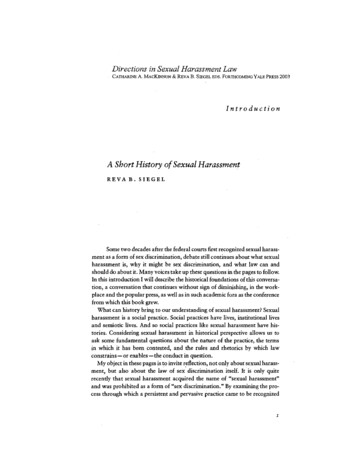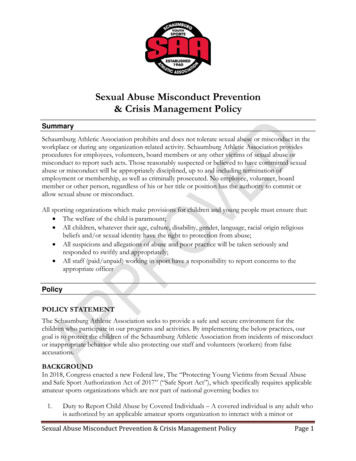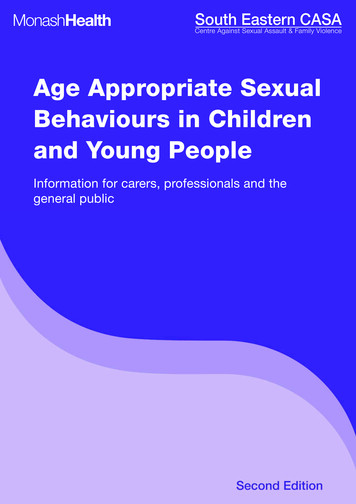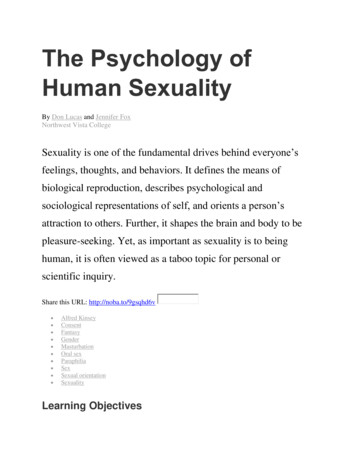
Transcription
Directions in Sexual Harassment LawCATHAlUNE A MACKINNON & REVA B. SIEGEL EDS. FORTHCOMING YALE PRESS 2003IntroductionA Short History of Sexual HarassmentREVA B. SIEGELSome two decades after the federal courts first recognized sexual harassment as a form of sex discrimination, debate still continues about what sexualharassment is, why it might be sex discrimination, and what law can andshould do about it. Many voices take up these questions in the pages to follow.In this introduction I will describe the historical foundations of this conversation, a conversation that continues without sign of diminishing, in the workplace and the popular press, as well as in such academic fora as the conferencefrom which this book grew.What can history bring to our understanding of sexual harassment? Sexualharassment is a social practice. Social practices have lives, institutional livesand semiotic lives. And so social practices like sexual harassment have histories. Considering sexual harassment in historical perspective allows us toask some fundamental questions about the nature of the practice, the termsin which it has been contested, and the rules and rhetorics by which lawconstrains-or enables-the conduct in question.My object in these pages i tQ invite r.eflection, not only about sexual harassment, but also about the law of sex discrimination itself. It is only quiterecently that sexual harassment acquired the name of "sexual harassment"and was prohibited as a form of "sex discrimination." By examining the process through which a persistent and pervasive practice came to be recognizedr
2Reva B. Siegelas discrimination "on the basis of sex," we learn much about what law doeswhen it recognizes discrimination.Clearly, this act of recognition was a momentous one. For the first time inhistory, women extracted from law the means to fight a practice with whichthey had been struggling for centuries. And yet, when we consider this development from a historical vantage point, it becomes plain that legal recognition of sexual harassment as sex discrimination was at one and the same time aprocess of misrecognition- involving a sometimes strange account of thepractice in issue. On a moment's reflection, this is not terribly surprising.When law recognizes the harms inflicted by social practices, it is intervening inthe social world it is describing, both enabling and constraining challenges tothe social order of which the practices are a part.For this reason, the language of discrimination is a specialized language, onethat describes the social world in selective ways. When we in turn talk about apractice in the language of discrimination, we are viewing the world throughthis conceptual filter. Recourse to history supplies one way in which we canthink about the languages in which we characterize the social world, to consider what work they are doing, and to ask again what work we might havethem do.It is in that spirit that I offer the following short history of sexual harassment, as a prelude to a much larger conversation, and as a provocation ofsorts: an invitation to meditate, yet again, on what we mean when we say thata practice discriminates "on the basis of sex." The longer I think about whatthat proposition might mean, the more I appreciate how its elusive meaning isthe very source of its power-its maddening capacity to excite and to deadencuriosity, to challenge and to legitimate the social arrangements that makemen men and women women.It is with a view to continuing a several-decades-old conversation aboutwhat discrimination "on the basis of sex" might mean that I begin my shorthistory of sexual harassment at a time well before anyone dreamed of describing the practice in such terms. I begin my story, quite self-consciously, with aprovisional account of what sexual harassment might be and end by speculating about some ways that the practice seems to be changing in our own day. Inthis way, I hope to survey the terrain of the debate that the essays in this bookjoin- a debate about what sexual harassment is and what law should doabout it, a debate about the terms in which we describe apd remedy thewrongs we have only recently come to call "discrimination."
Introduction3Some Historical Perspectives on the Practice, Protest,and Regulation of Sexual HarassmentThe practice of sexual harassment is centuries old -at least, if we definesexual harassment as unwanted sexual relations imposed by superiors on subordinates at work. For example, sexual coercion was an entrenched feature ofchattel slavery endured by African-American women without protection oflaw. 1 While there were crucial differences in the situation of free women employed in domestic service, they, too, commonly faced sexual advances by menof the households in which they worked. 2 Surviving accounts of women employed in manufacturing and clerical positions in the late nineteenth and earlytwentieth centuries also point to a variety of contexts in which men imposedsexual relations- ranging from assault to all manner of unwanted physical orverbal advances- on women who worked for them. 3Nor was this sex shrouded in silence. Since the antebellum period, there hasbeen public discussion of women's vulnerability to coerced sexual relations atwork. To be sure, Americans often blamed women's sexual predicament onwomen themselves; both slaves and domestic servants were often judged responsible for their own "downfall" because they were promiscuous by nature.4 Yet an equally powerful line of public commentary condemned men forsexually abusing the women who worked for them. The abolitionist press, forexample,· "was particularly fond of stories that involved the sexual abuse offemale slaves by their masters"5 as such stories directly put in issue the morality and legitimacy of slavery. And sexual relationships between women and themen for whom they worked as domestic servants were, if anything, even morevolubly discussed. Over the decades, governmental hearings and reports, aswell as all manner of commentary in the public press, delved into this andother aspects of the "servant problem."6 Thus, by the close of the nineteenthcentury, we .find Helen Campbell's I887 report on Women Wage-Workersinvoking the common understanding that "[h]ousehold service has becomesynonymous with the worst degradation that comes to woman." 7 Campbellalso described in some detail the forms of sexual extortion practiced uponwomen who worked in factories and in the garment industry. 8 Along similarlines, Upton Sinclair's I905 expose, The Jungle/ dramatized the predicamentof women in the meat-packing industry by comparing the forms of sexualcoercion practiced in "wage slavery" and chattel slavery:Here was a population, low-class and mostly foreign, hanging always on theverge of starvation, and dependent for its opportunities of life upon the whimof men every bit as brutal and unscrupulous as the old-time slave drivers; undersuch circumstances immorality was exactly as inevitable, and as prevalent, as it
4Reva B. Siegelwas under the system of chattel slavery. Things that were quite unspeakablewent on there in the packing houses all the time, and were taken for granted byeverybody; only they did not show, as in the old slavery times, because therewas no difference in color between the master and slave .10As public commentators such as Campbell and Sinclair and the abolitionistsbefore them well appreciated, the American legal system offered women scantprotection from sexual coercion at work. Rape was, of course, punishable bylaw; but the criminal law did not protect slaves from rape, 11 and it defined theelements of rape so restrictively that most free women sexually coerced atwork would have little reason to expect the state to sanction the men who tookadvantage of them.Few women were willing to endure the damage to reputation and prospectsfor marriage that followed from bringing a rape complaint, and if they did, theprospects for vindication of their complaint were remote indeed. The commonlaw required a woman claiming rape to make a highly scripted showing thatsexual relations were nonconsensual; she had to show that sex was coerced byforce and against her will 12 -that she succumbed to overpowering physicalforce despite exerting the "utmost resistance." 13 Economic coercion did notsuffice, nor was most physical resistance enough to satisfy the co.mmon lawrequirement of "utmost resistance." New York's high court explained in r 874,as it rejected a rape prosecution of a man who forcibly assaulted his fourteenyear-old servant girl, after sending away her younger siblings and locking herin his barn: "Can the mind conceive of a woman, in the possession of herfaculties and powers, revoltingly unwilling that this deed should be done uponher, who would not resist so hard and so long as she was able? And if awoman, aware that it will be done unless she does resist, does not resist to theextent of her ability on the occasion, must it not be that she is not entirelyreluctant? If consent, though not express, enters into her conduct, there is norape." 14In short, the law assumed that women in fact wanted the sexual advancesand assaults that they claimed injured them. Unless women could show thatthey had performed an elaborate ritual of resistance, perfect compliance withthe legally specified terms of which was necessary to overcome the overwhelming presumption that women latently desired whatever was sexually done tothem, they could expect little recourse from the criminal law. Rape law'sprotection was further vitiated by the fact that prosecutors and judges reliedon all kinds of race- and class-based assumptions about the "promiscnous"natures of the women in domestic service and other forms of market labor asthey reasoned about utmost resistance. 15
Introduction5Tort law was only marginally more effective as a weapon against sexualcoercion at work. Initially, tort law gave women no right to recover damagesfor sexual assault. At common law, sexual assault gave rise to an action fordamages insofar as it inflicted an injury on a man's property interest in thewoman who was assaulted; thus, a master might have a claim in trespass 1against a man who raped his slave, 16 or a father niight bring a seduction actionagainst an employer who impregnated or otherwise defiled his daughter. 17 ;When American law eventually began to recognize a woman's right to recoverfor sexual· injury in her own right-whether through an action for seductionor indecent assault- tort law developed a specialized body of law on "sexual"touchings that incorporated doctrines of consent from the criminal law ofrape. 18 By the early twentieth: century, some jurisdictions moderated the consent requirement in actions for indecent assault, but none seems to have relinquished it. 19 The tort action for seduction, by contrast, seems to have beenmore plastic, as it evolved from an action designed to recompense a father'seconomic injli.ry (when it focused on his daughter's out-of-wedlock pregnancy) to an action designed to recompense injuries to a father's honor (whenit focused his daughter's loss of virginity) to an action designed to recompensewomen directly for injuries suffered in "sexual connexion." 20 In this newlyconfigured form, Lea VanderVelde reports, by the late nineteenth centurythere were at least some seduction cases in which "the coercive force of wordsof economic threat were sufficient to render the sexual predation redressible."21 But this development was by no means uniform across jurisdictions22and was, moreover, short-lived: by the early twentieth century, many statesbegan legislatively to repeal the tort of seduction along with other "heartbalm" actions.23The law's failure to protect women from sexual predation at work did not, ofcourse, pass unnoticed; it has been a subject of protest since the days of theantislavery movement. We might count in this tradition abolitionist HenryWright's description of South Carolina as "one great legalized and baptizedbrothel,"24 or Harriet Jacobs's Incidents in the Life of a Slave Girl,Z 5 or thepetitions of Henry McNeal Turner and other African-American men in theaftermath of the Civil War who protested the sexual violation of black womenin domestic service: "All we ask of the white man is to let our ladies alone, andthey need not fear us." 26 As the story of Turner's petition reminds us, the partiesmost interested in achieving law reform in such matters were for the most partdisfranchised. Petition thus emerged as a crucial weapon in the campaign. Forexample, even before the movement for woman suffrage emerged in the r84os,women's moral reform societies had begun to wage petition campaigns designed to persuade state legislatures to enact legal penalties for seduction.27The
6Reva B. Siegelcampaign to reform tort law had both practical and expressive purposes.Abolitionist Lydia Maria Child described the dignitary affront of a tort regimethat recognized the sexual injury of women as an economic loss to men. Sheprotested the common law of seduction as it denied to women the legal subjectivity to sustain sexual injury and the legal agency to secure its redress, andargued that women had internalized their devaluation and objectification bylaw: "[A) woman must acknowledge herself the servant of some-body, whomay claim wages for her lost time! . It is a standing insult to womankind; andhad we not become the slaves we are deemed in law, we should rise en masse .and sweep the contemptible insult from the statute-book.''28With the rise of the woman's rights movement in the decade before the CivilWar, some of its more vocal spokespersons began to discuss the socioeconomic conditions that made women susceptible to sexual coercion. The portrait they painted of heterosexual interaction was completely at odds with thecommon law's, insofar as it presented coercion as the normal rather thandeviant condition of heterosexual relations. On this account, restrictions onwomen's labor market participation ("crowding") and the systematic depression of their wages left women as a class dependent on men for economicsupport, and it was in this condition of "pecuniary dependence" that mencould extract their sexual compliance, in and out of marriage. 29 As ErnestineRose explained at an r8 56 woman's rights convention: "What was left for herbut to sell herself for food and clothing either in matrimony or out of it; and itwould require a wise head to determine which was the worse.'' 30In this critique of marriage as "legalized prostitution" 31 the woman's rightsmovement had begun to analyze the political economy of heterosexuality in away that took as structurally interconnected the institutions of marriage andmarket. This socioeconomic understanding of sexual relations shaped themovement's response to the trial of domestic servant Hester Vaughn in theaftermath of the Civil War. Vaughn was fired by her employer when she became pregnant by him; she gave birth alone, ill, and impoverished, and wasfound several days later with her dead infant by her side, adjudged guilty ofinfanticide, and sentenced to death. 32 As Elizabeth Cady Stanton, Susan B.Anthony, and other woman's rights advocates publicized the Vaughn case,they pointed to a variety of gendered injustices that cumulatively sealedVaughn's fate-an analysis that started with the gender and class restrictionsthat drove Vaughn to domestic service, and the sexual vulnerability her economic dependency engendered.33 For the woman's rights movement, theVaughn case presented an occasion to protest the economic arrangements andsocial understandings that visited the judgment of death on Vaughn for a
Introduction7predicament the woman's movement judged society as a whole-and men inparticular- culpable.The woman's rights movement responded to Vaughn's case with wideranging social critique and an equally wide-ranging remedy. The movementdrew on Vaughn's case to protest the injustice of women's exclusion from juryservice and suffrage and, after persuading the governor of Pennsylvania topardon her, turned the Vaughn episode in the direction of its larger quest forpolitical empowerment. 34 During the late nineteenth century, only the Woman's Christian Temperance Union mounted a sustained effort to reform lawsprotecting women from sexual predation; as Jane Larson has recounted, theireffort took the form of a national campaign to raise the age of consent forstatutory rape law. 35 While the campaign spoke the language of moral purity,Larson has shown that it was centrally preoccupied with the failure of rapelaw to protect women from sexual predation, and at least some of its centrallypublicized cases involved the sexual exploitation of young women workers. 36For the most part, efforts to protect working women from sexual coercionin the early twentieth century focused, not on law reform, but on other modesof collective self-help. For example, in I 908, settlement workers Grace Abbottand Sophonisba Breckinridge took a saloon-keeper to court who fired a youngbarmaid when he discovered that she was about to bear a child by him; afterlosing the case, Abbott and Breckinridge they turned to organizing immigrantprotectiye associations to provide young working women alternate bases ofcommunity support. 37 Outside the settlement movement, various labor activists addressed the issue of women's vulnerability to sexual coercion at work aspart of a more wide-ranging effort to organize working women. 38 But as LisaGranik relates, there were pressures on women workers struggling to organizethat caused them to defer gender-specific demands- such as protection fromsexual coercion- in favor of traditional union demands such as seniorityrights. 39Even so, the fusion of labor and feminist advocacy agendas in the progressiveera bore critical fruit. In I 9 I 6, for example, socialist-feminist Emma Goldmanelaborated the "legal prostitution" critique of the nineteenth-century woman'srights movement in her influential essay "The Traffic in Women": "Nowhere iswoman treated according to the merit of her work, but rather as a sex. It istherefore almost inevitable that she would pay for her right to exist, to keep aposition in whatever line, with sex favors. Thus it is merely a question of degreewhether she sells herself to one man, in or out of marriage, or to many men.Whether our reformers admit it or not, the economic and social inferiority ofwoman is responsible for prostitution."40
8Reva B. SiegelWomen in the early feminist and labor movements never managed to organize a sustained assault on the set of practices we have come to call "sexualharassment," but they did articulate an indictment of the practices that anticipated many of the arguments that women in the modem feminist and labormovements voiced in the 1970s.The Rise of Sexual Harassment Law:Regulating Sexual Harassment as Sex DiscriminationAs we have· seen, the practice and protest of sexual harassment have along history, in which we can situate developments of the 1970s as a recentand relatively short chapter. But these developments nonetheless represent adramatic turning point in social and legal understandings of the practice.In the 1970s Catharine MacKinnon and Lin Farley and the many otherlawyers and activists who represented women in and out of court were able tomount a concerted assault, of unprecedented magnitude and force, on thepractice of sexual harassment. Responding on many fronts to the demands ofthe second-wave feminist movement, the American legal system began slowlyto yield to this challenge, and for the first time recognized women's right towork free of unwanted sexual advances.How did this come about? Sexual harassment law arose, first and foremost,from women acting as part of a· social movement speaking out about theirexperiences as women at work; the term "sexual harassment" itself grew outof a consciousness-raising session Lin Farley held in I 97 4 as part of a CornellUniversity course on women and work. 41 But more was required for the American legal system to recognize this experience of gendered harm as a form oflegal injury, when for centuries it had refused. We could speculate for a longtime about the convergence of social forces and social understandings thaten a bled legal recognition of the sexual harassment claim- a story involvingdifferences in the movements for race and gender emancipation in the nineteenth and twentieth centuries, shifts in women's labor force participation,and much more. But for present purposes I would like to consider the questionin rather modest terms. What new ways of talking about the harms of acenturies-old practice enabled its recharacterization as unlawful conduct?FEMI IST ACCOUNTS OF SEXUAL HARASSMENTAS SEX DISCRIMINATION .As we know, the practice of subjecting employees to unwanted sexualadvances at work was made legally actionable under a particular legal regime,Title VII of the Civil Rights Act of 1964.42 During the 1970s, lawyers, advo-
Introduction9cates, and theorists had to persuade the American judiciary that sexual harassment is "discrimination on the basis of sex." For this to happen, the injuriesinflicted on women by sexual coercion at work had to be presented to courts interms that could be assimilated to a body of law adopted to regulate practicesof racial segregation in the workplace. Catharine MacKinnon's analysis inSexual Harassment of Working Women 43 - a stunningly brilliant synthesis oflawyering and legal theory- played a crucial role in this process.I want now briefly to revisit the 1970s campaign, with a view to understanding the legal system's "reception" of the sexual harassment claim, its translation into antidiscrimination discourse. By considering how MacKinnon andFarley described the injury of sexual harassment, and how judges interpretingfederal employment discrimination law explained the harm of the practice, welearn much, not only about sexual harassment, but, just as important, aboutwhat law does when it recognizes claims of discrimination.Writing in the 1970s, MacKinnon and Farley had only sketchy knowledgeof the history we have just surveyed; much of this scholarship was produced asan outgrowth of the same set of social transformations that gave rise to thesexual harassment claim in the 1970s. Nevertheless, there are certain strikingparallels between their arguments, and arguments advanced by Child, Rose,Stanton, Anthony, and Goldman before them. Like these early advocates,MacKinnon and Farley understood the sexual coercion women encounteredat work as part of the larger political economy of heterosexuality, a socialorder that situates sexual relations between men and women in relations ofeconomic dependency between men and women, an order in which marriageand market play reinforcing roles in the reproduction of women's social subordination as a class. 44 As MacKinnon wrote in 1979: "Sexual harassment perpetuates the interlocked structure by which women have been kept sexually inthrall to men and at the bottom of the labor market. Two forces of Americansociety converge: men's control over women's sexuality and capital's controlover employees' work lives. Women historically have been required to exchange sexual services for material survival, in one form or another. Prostitution and marriage as well as sexual harassment in different ways institutionalize this arrangement."45Farley and MacKinnon each then proceeded to read the sexual advancesconstituting harassment within a semiotics of status inequality. Farley definedsexual harassment as the "unsolicited nonreciprocal male behavior that asserts a woman's sex role over her function as a worker."46 Drawing on sourcesas diverse as Adrienne Rich and Erving Goffman, Farley asserted that thepractice of sexual harassment was properly understood within the «micropolitics" of "the patriarchy." She drew upon psychologists and sociologists to
IoReva B. Siegeldecode the pract.lce as part of "the communication of power between persons," insisting that "sex is hardly the real meaning of much male behavior atwork."47 MacKinnon, in a now-familiar voice, tersely remarked: "Sexual assault as experienced during sexual harassment seems less than an ordinary actof sexual desire directed toward the wrong person than an expression ofdominance laced with impersonal contempt, the habit of getting what onewants, and the perception (usually accurate) that the situation can be safelyexploited in this way-all expressed sexually. It is dominance eroticized."48MacKinnon located this relationship within a system of social relations thatdivided the workforce into gender-marked roles that sexualized inequality onthe model of marriage: "Work relationships parallel traditional home relationships between husband and wife" so that "women's employment outside thehome tends to monetize the roles and tasks women traditionally perform formen in the home." 49Looking back at Farley and MacKinnon's arguments, we can discern thebasic outlines of a social account of gender. Social stratification along lines ofgender has material and dignitary dimensions; it is produced by the interactionof social structure (institutions, practices) and social meaning (stories, reasons );50 sexual harassment is part of the relations of distribution and recognition both.51This set of understandings played a central role in MacKinnon's argumentthat sexual harassment was sex discrimination: "Practices which express andreinforce the social inequality of women to men are clear cases of sex-baseddiscrimination in the inequality approach!' 52 She then illustrated how sexual· harassment expressed and reinforced sexual inequality as a matter of socialstructure and social meaning: for example, "Sexual harassment is discrimination 'based on sex' within the social meaning of sex, as the concept is sociallyincarnated in sex roles. Pervasive and 'accepted' as they are, these rigid roleshave no place in the allocation of social and economic resources." 53 Of course,in so arguing, MacKinnon was engaged in a creative act of resistance, couching the claim that sexual harassment was sex discrimination in terms thatexpressed the experiential and theoretical understanding of harassment thathad emerged from the women's movement, even as her arguments divergedfrom the conceptual framework in which the American legal system had cometo apprehend race and sex discrimination by the mid-I970s.This set of more conventional legal understandings MacKinnon termed the"differences approach": "The basic question the differences approach poses is:how can you tell that this happened because one is a woman, rather than to aperson who just happens to be a woman? The basic answer . is: a man in herposition would not be or was not so treated." 54 Employers may take all kinds
IntroductionIIof adverse employment actions against women; what they may not do is treatwomen employees differently than they treat, or would treat, male employees.Note how, on this conception of discrimination, the harm of sexual harassment no longer involves interaction of social structure and social meaning, butinstead reduces to an inquiry into the criteria by which an employersortsemployees. MacKinnon offered a variety of arguments that sexual harassmentwas sex discrimination on the differences approach, while at the same timeconducting a detailed diagnosis of how the antidiscrimination tradition wasmisrecognizing status harm in the course of recognizing discrimination. 55Without rehearsing the different iterations of disparate treatment and disparate impact arguments MacKinnon and others offered in briefing the sexualharassment claim in more conventional legal terms, I would like, in the interests of concision, to consider how, as a matter of history, the American legalsystem made sense of the proposition that sexual harassment was sex discrimination within the meaning of Title VII. Much was gained, and lost, in this actof "recognition."RESISTANCE AND (MIS)RECOGNITION:HOW COURTS TRANSFORMED SEXUAL HARASSMENT DISCOURSE.At first, courts simply refused to acknowledge that sexual harassmenthad anything to do with employment discrimination on the basis of sex. Sexual harassment was rejected as a personal matter having nothing to do withwork 56 or a sexual assault that just happened to occur at work .57 Alternatively,judges reasoned that sexual harassment was natural and inevitable and nothing that law could reasonably expect to eradicate from work. 58 But the centralground on which courts resisted recognizing the claim was simply that sexualharassment was not discrimination "on the basis of sex." It could happen to aman or woman or both;59 even if its harms were inflicted on women only, theywere not inflicted on all women, only those who refused their supervisors'advances. 60 It is worth examining the objections to recognizing sexual harassment as sex discrimination set forth in these early cases, and the legal arguments that ultimately prevailed against them. By reconstructing the processthrough which courts came to reason that that sexual harassment discriminates "on the basis of sex," we learn much about the ways that antidiscrimination law selectively constrains practices that sustain social stratification.61Courts initially offered two reasons to support the judgment that supervisors who subjected employees to unwanted sexual advances did not discriminate on the basis of sex. The first objection was that the practice did notsystematically differentiate among employees by sex. As one district courtreasoned: "In this instance the supervisor was male and the employee was
r2Reva B. Siegelfemale. But no immutable principle of psychology compels this alignment ofparties. The gender lines might as easily have been reversed or even not crossedat all. While sexual desire animated the parties, or at least one of them
suffice, nor was most physical resistance enough to satisfy the co.mmon law requirement of "utmost resistance." New York's high court explained in r 87 4, as it rejected a rape prosecution of a man who forcibly assaulted his fourteen year-old servant girl











